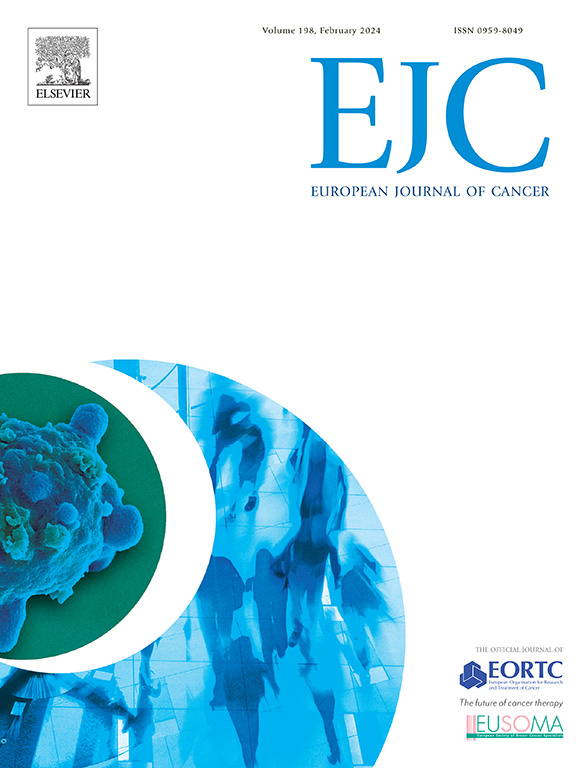Genomic profiling of primary tumor and lymph node metastasis in patients with clinically node-positive breast cancer: prospective cohort study within TAXIS (OPBC-03, SAKK 23/16, IBCSG 57–18, ABCSG-53, GBG 101)
IF 7.6
1区 医学
Q1 ONCOLOGY
引用次数: 0
Abstract
Introduction
Genomic tests informing systemic therapy recommendations for breast cancer (BC) were developed and validated on primary tumor (PT) tissue. Agreement of genomic tests between the PT and matched lymph node metastases (LNm) in patients with BC is currently unclear, which limits their use in nodal tissue.
Methods
Prespecified study within the international phase III TAXIS trial (NCT03513614). Tissue from PT and matched LNm were assessed with the primary objective of comparing genomic recurrence risk and subtypes. Clinical risk was assessed using the Adjuvant!Online tool and clinical subtypes were determined based on hormone receptor and Her2 testing. Agreement was assessed using Cohen’s Kappa (Κ).
Results
Eighty-nine patients with stage II/III BC from 26 European centers were included. Median age was 63 years (range 50–72). Agreement in genomic risk between the PT and LNm was found in 84.3 % (Κ=0.64). However, 15.6 % exhibited genomic high risk in the LNm and low risk in the PT, while 16.0 % demonstrated low risk in the LNm and high risk in the PT. Genomic subtypes of PT and LNm showed disagreement in 17.1 % of patients with luminal BC (Κ=0.70). 96.5 % of patients were clinically categorized as high risk, whereas genomically, 25.6 % of them were classified as low risk in the LNm (Κ=0.17) and 31.7 % in the PT (Κ=0.13). Genomic subtyping reclassified 35.5 % of the clinically luminal tumor subtypes.
Conclusion
Disagreement in genomically estimated risk exists in over 15 % of patients, potentially leading to over- or undertreatment. Consequently, the applicability of genomic tests in LNm remains controversial.

临床淋巴结阳性乳腺癌患者原发肿瘤和淋巴结转移的基因组分析:TAXIS前瞻性队列研究(OPBC-03, SAKK 23/16, IBCSG 57-18, abcsg 53, GBG 101)
基因组测试提示乳腺癌(BC)的全身治疗建议,并在原发肿瘤(PT)组织中进行了开发和验证。在BC患者中,PT和匹配的淋巴结转移(LNm)之间的基因组测试的一致性目前尚不清楚,这限制了它们在淋巴结组织中的应用。方法在国际III期TAXIS试验(NCT03513614)中进行再指定研究。对来自PT和匹配的LNm的组织进行评估,主要目的是比较基因组复发风险和亚型。临床风险评估使用佐剂!根据激素受体和Her2检测确定在线工具和临床亚型。使用Cohen 's Kappa (Κ)评估一致性。结果纳入来自26个欧洲中心的89例II/III期BC患者。中位年龄为63岁(范围50-72岁)。PT和LNm在基因组风险上的一致性为84.3 % (Κ=0.64)。然而,15.6% %的患者在LNm中表现出基因组高风险,在PT中表现出低风险,而16.0% %的患者在LNm中表现出低风险,在PT中表现出高风险。17.1% %的患者在管腔BC中表现出PT和LNm的基因组亚型不一致(Κ=0.70)。96.5 %的患者在临床上被归为高风险,而基因组学上,25.6 %的患者在LNm (Κ=0.17)和31.7 %的患者在PT (Κ=0.13)中被归为低风险。基因组亚型重分类35.5% %的临床腔内肿瘤亚型。结论超过15% %的患者存在基因风险不一致,可能导致治疗过度或治疗不足。因此,基因组测试在LNm中的适用性仍然存在争议。
本文章由计算机程序翻译,如有差异,请以英文原文为准。
求助全文
约1分钟内获得全文
求助全文
来源期刊

European Journal of Cancer
医学-肿瘤学
CiteScore
11.50
自引率
4.80%
发文量
953
审稿时长
23 days
期刊介绍:
The European Journal of Cancer (EJC) serves as a comprehensive platform integrating preclinical, digital, translational, and clinical research across the spectrum of cancer. From epidemiology, carcinogenesis, and biology to groundbreaking innovations in cancer treatment and patient care, the journal covers a wide array of topics. We publish original research, reviews, previews, editorial comments, and correspondence, fostering dialogue and advancement in the fight against cancer. Join us in our mission to drive progress and improve outcomes in cancer research and patient care.
 求助内容:
求助内容: 应助结果提醒方式:
应助结果提醒方式:


